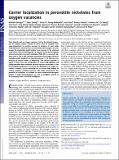Carrier localization in perovskite nickelates from oxygen vacancies
Author(s)
Kotiuga, Michele; Zhang, Zhen; Li, Jiarui; Rodolakis, Fanny; Zhou, Hua; Sutarto, Ronny; He, Feizhou; Wang, Qi; Sun, Yifei; Wang, Ying; Aghamiri, Neda Alsadat; Hancock, Steven Bennett; Rokhinson, Leonid P; Landau, David P; Abate, Yohannes; Freeland, John W; Comin, Riccardo; Ramanathan, Shriram; Rabe, Karin M; ... Show more Show less
DownloadPublished version (1.498Mb)
Publisher Policy
Publisher Policy
Article is made available in accordance with the publisher's policy and may be subject to US copyright law. Please refer to the publisher's site for terms of use.
Terms of use
Metadata
Show full item recordAbstract
Point defects, such as oxygen vacancies, control the physical properties of complex oxides, relevant in active areas of research from superconductivity to resistive memory to catalysis. In most oxide semiconductors, electrons that are associated with oxygen vacancies occupy the conduction band, leading to an increase in the electrical conductivity. Here we demonstrate, in contrast, that in the correlatedelectron perovskite rare-earth nickelates, RNiO3 (R is a rare-earth element such as Sm or Nd), electrons associated with oxygen vacancies strongly localize, leading to a dramatic decrease in the electrical conductivity by several orders of magnitude. This unusual behavior is found to stem from the combination of crystal field splitting and filling-controlled Mott-Hubbard electron-electron correlations in the Ni 3d orbitals. Furthermore, we show the distribution of oxygen vacancies in NdNiO3 can be controlled via an electric field, leading to analog resistance switching behavior. This study demonstrates the potential of nickelates as testbeds to better understand emergent physics in oxide heterostructures as well as candidate systems in the emerging fields of artificial intelligence.
Date issued
2019-10Department
Massachusetts Institute of Technology. Department of PhysicsJournal
Proceedings of the National Academy of Sciences
Publisher
National Academy of Sciences
Citation
Kotiuga, Michele et al. "Carrier localization in perovskite nickelates from oxygen vacancies." Proceedings of the National Academy of Sciences 116, 44 (October 2019): 21992-21997 © 2019 National Academy of Sciences
Version: Final published version